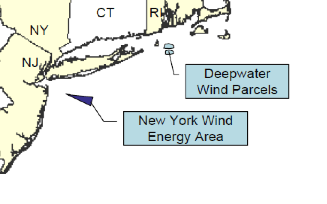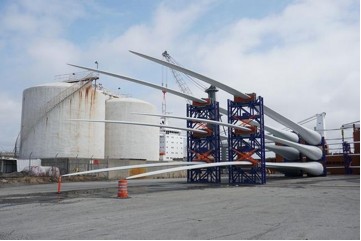August 23, 2016
by Don Hughes
Thursday, June 2, 2016 was a banner day for the development of wind energy off the shores of Long Island and New Jersey. The Department of Interior announced the proposed auction of leases for 81,130 acres for commercial wind energy installations. The lease area is a wedge-shaped piece of seabed approximately 11 miles south of Long Island’s Rockaway peninsula, also known as the New York Wind Energy Area (see map below). Interior’s Bureau of Ocean Energy Management (BOEM) identified this area for wind energy in consultation with members of the New York Intergovernmental Renewable Energy Task Force, which includes federal, state, tribal and local government partners. An offshore natural gas import facility, “Port Ambrose,” had been proposed for this very area; Governor Cuomo vetoed its construction late last year.
On the very same day, the New York State Energy Research and Development Authority (NYSERDA) announced that it will participate in Interior’s BOEM auction for a commercial offshore wind energy lease of that area. The press release noted that “Offshore wind is a critical component in meeting Governor Andrew M. Cuomo’s aggressive clean energy goals, including generating 50 percent of the state’s electricity from renewables by 2030. By taking this action to participate in the lease auction, NYSERDA will seek to ensure offshore wind in New York will be developed at the lowest possible cost for electricity consumers while protecting the environment and growing the economy.”
These actions set the stage for what is slated to be New York State’s first large-scale offshore wind farm. It is estimated that over 600 megawatts (MW) could be generated from such an installation. To put this in perspective, the Shoreham nuclear power on Long Island—never operational—was a 540-MW plant. Unlike traditional power plants fueled by natural gas, coal or oil, wind farms have the major advantage of not emitting greenhouse gases. Wind power is far cleaner, less expensive, and safer than nuclear power. And wind power does not depend on a steady supply of raw materials extracted from the Earth at great cost to the environment, be it uranium and coal from mining, or gas extracted via hydrofracking.
The auction was subject to a 60-day public comment period which ended August 5. In addition, BOEM published an Environmental Assessment (EA) for public comment, which ended July 13. The EA considers potential impacts associated with a large-scale wind project, including geophysical surveys, installation of a meteorological tower, and installation of the wind towers. The next steps in the process are: (1) conclusion of the EA, once public comments are considered, and (2) publication of the Final Sale Notice, which will announce the time and date of the lease sale. As of June 2016, seven companies have qualified to bid in the lease sale.
 Figure 1. NY Wind energy development area off the coasts of Long Island and New Jersey, and Deepwater ONE parcels near Block Island.
Figure 1. NY Wind energy development area off the coasts of Long Island and New Jersey, and Deepwater ONE parcels near Block Island.At the other end of Long Island, another, smaller wind project is about to get underway. The Long Island Power Authority recently requested bids for proposals to relieve the impending electrical energy shortage on the fast-growing South Fork at the east end of Long Island. One of the bids received was a proposal from Deepwater Wind, LLC, a Rhode Island company, to construct a 90-megawatt, 15-turbine wind farm. The turbines would be placed about 30 miles east of Montauk Point, inside a federal wind development site leased to Deepwater Wind. The company won a 30-year lease to develop the Deepwater ONE project in July 2013. The entire site consists of two parcels totaling approximately 256 square miles. The company plans to expand on its wind capacity over the coming years. The turbines are distant enough from LI and most of the New England coast to be out of view.
A variety of other proposals were received, including some for battery energy storage facilities that could be used to store energy delivered to the area at times when more can be delivered than is needed; this energy would be released at times of peak demand in late summer afternoons. LIPA would purchase enough energy to power approximately 50,000 homes on the south fork of Long Island. LIPA’s board was set to approve the Deepwater proposal and others on July 20, but the meeting was postponed. The authority is expected to approve the proposal within the next few weeks.
LIPA’s chief executive officer, Thomas Falcone, said in a July 13 interview with the Associated Press, “I think this is a very big step . . . for New York, but also for the United States.” Exact financial terms between LIPA and Deepwater Wind still need to be negotiated, Falcone said, but he expressed optimism an agreement could be reached by early 2017. It is anticipated that power could be reaching Long Island customers by the end of 2022, depending on the permitting process. Numerous environmental studies of the area have already been completed.
History of wind development in the US
The development of offshore wind energy has been progressing very slowly in the United States. After years of delays and roadblocks, a demonstration 30-megawatt offshore wind farm in US waters is now being constructed off the coast of Rhode Island, near Block Island, by Deepwater Wind. According to Bloomberg News, workers are set to complete construction of the five 589-foot turbines by the end of August. The 30-megawatt, $300 million project is expected to begin commercial operation in November 2016. It will replace expensive electricity produced for Block Island by diesel generators on the island; energy in excess of Block Island’s needs will be sent by undersea cable to the mainland.
 Figure 2. Blades for the Block Island Wind Farm arrive at ProvPort. Source: Providence Journal/Sandor Bodo
Figure 2. Blades for the Block Island Wind Farm arrive at ProvPort. Source: Providence Journal/Sandor BodoThere is movement to build more offshore wind facilities in US waters. In addition to New York, the federal government has awarded leases to companies to develop wind projects off New Jersey, Rhode Island, Massachusetts, Maryland and Virginia. On August 8, Massachusetts Governor Charlie Baker signed a bill that requires Massachusetts to solicit long-term contracts — lasting 15 or 20 years — to procure 1,600 megawatts of offshore wind power. The bill also calls for another 1,200 megawatts of electricity to come from hydropower or other renewable resources, such as land-based wind or solar. Unfortunately, the bill may promote expansion of large hydropower projects in Canada. These projects flood immense tracts of land, disrupting ecosystems and displacing indigenous people who have lived in harmony with the environment for centuries.
In the meantime, offshore wind energy has progressed by leaps and bounds in Europe. Nearly 10,000 megawatts of offshore wind power has been installed in Germany, the UK and Denmark alone. On August 16, the UK approved what will be the world’s largest offshore wind farm: an 1,800-megawatt installation off the Yorkshire coast that will cost £6 billion ($7.8 billion).
Environmental impacts
Installation of large offshore wind projects is not without environmental impacts. Specific concerns raised by the Sierra Club, National Wildlife Federation and other environmental groups note that three federally protected whale species are often found in waters off Long Island, including the highly endangered North Atlantic right whale (Eubalaena glacialis), fin whale (Balaenoptera physalus), and the humpback whale (Megaptera novaeangliae). The effect of construction-related noises and collisions with ships are the main concerns for whales. The construction of the Block Island wind farm was timed to avoid known times of whale migration. Other species of concern are turtles, including the endangered Kemp’s ridley (Lepidochelys kempii). These are also affected by noises and collisions with ships. It is possible, but not fully known, whether electromagnetic fields from undersea transmission lines affect turtle navigation. The Sierra Club and other groups have requested that these effects be studied closely, and mitigation measures used to minimize adverse impacts.
Overall, the impacts of wind power on sea life are minimal in comparison to the devastating impacts of climate change and ocean acidification caused by the combustion of fossil fuels.
Summary
Wind power is finally gaining a toehold in the US. The first wind project — a 5-tower installation off Block Island — is about to go on-line this fall. This will be followed by a 15-tower Deepwater Wind installation off eastern Long Island, expected to go on-line in 2022. Finally, if NYSERDA succeeds in winning the BOEM bid, then a third wind installation will be built off the Rockaway peninsula.
Sources:
(1) Department of the Interior, Office of the Secretary, “Interior Announces Milestone for New York Offshore Commercial Wind Energy.” Press Release, dated June 2, 2016
(2) NYSERDA. “New York State to Participate in Offshore Wind Lease Auction.” Press Release, dated June 2, 2016
http://www.nyserda.ny.gov/About/Newsroom/2016-Announcements/2016-06-02-New-York-State-to-Participate-in-Offshore-Wind-Lease-Auction
(3) Christopher Walsh (July 15, 2016) “LIPA to Approve Wind Farm 30 Miles Off Montauk,” The East Hampton Star. http://easthamptonstar.com/Government/2016715/LIPA-Approve-Wind-Farm-30-Miles-Montauk
(4) PROVIDENCEJOURNAL.COM “Deepwater Wind has deal to sell power to Long Island from RI wind farm.” Posted Jul. 14, 2016 at 10:43am; updated at 2:14 pm.
(5) Natural Resources Defense Council (NRDC), Conservation Law Foundation (CLF), the National Wildlife Federation (NWF), and Sierra Club (July 13, 2016). Comments on the Environmental Assessment for Commercial Wind Lease Issuance and Site Assessment Activities on the Atlantic Outer Continental Shelf (OCS) Offshore New York; MMAA104000 (Docket No. BOEM-2016-0038) https://www.regulations.gov/document?D=BOEM-2016-0038-0030
(6) Shira Schoenberg “Gov. Charlie Baker signs hydropower, wind energy bill into law.” http://www.masslive.com/politics/index.ssf/2016/08/gov_charlie_baker_signs_hydrop.html, Posted on August 8, 2016 at 4:01 pm, updated at 4:19 pm